What Is The Kiva Method Against Bullying?

The Kiva method is a curriculum that Finland created to reduce bullying between kids ages 7 to 15. The program includes 10 lessons administered by a classroom teacher throughout the school year. In addition, it comes with computer games and a virtual environment for learning.
Bullying is a widespread problem with serious consequences for victims. Schools are strongly encouraged to implement both preventative and reactive measures. That way, they can prevent future problems and address existing bullying situations.
For many children, bullying is a long and terrible issue of continuous harassment. Sometimes, it includes injuries and exhaustion.
Even the most resistant children can have problems dealing with it. Bullying can also cause depression, anxiety and health problems.
To combat this, Finland discovered a method to stop this problem in its tracks. We’ll show you what it consists of in this article.
What is the Kiva method?
First, we must emphasize that Finland has one of the most successful education systems in the world. Therefore, it’s not surprising that they were pioneers in establishing a school bullying prevention program.
The anti-bullying program is called Kiva, which means “against harassment.” It’s an intimidation prevention scheme from the University of Turku in Finland. Now, many schools around the world have included it into their curriculum.
The method includes many different resources, such as tools for teachers and parents, as well as classroom lessons. It can also help reduce depression and increase self-esteem for children who have already been bullied.

The Kiva method involves everyone’s participation
The Kiva method actively involves the school and parents. It uses a multi-level approach to address factors at the individual, classroom and school levels. The curriculum consists of 10 lessons taught by classroom teachers for 20 hours.
Each lesson is built around a central theme and a rule associated with that topic. After the lesson, the class adopts that rule as a class norm. Then, at the end of the year, you combine all the rules in a contract, which all the students sign.
A program manual provides guidelines to teachers on how much time to spend on each topic. In addition, schools have the flexibility to decide how to organize the school year around the issues.
One of the most interesting aspects is how the program focuses on teaching peers what to do if they see bullying. Teachers aren’t always close, so they cannot always help. However, other students often are.
“What if the kid you bullied at school, grew up, and turned out to be the only surgeon who could save your life?”
–Lynette Mather–
For this reason, it’s very important that they’re aware of this phenomenon in order to have the keys to act. Then, they can help stop the bullying.
This method aims to convey this empathy to peers through computer games and simulations. In addition, it allows them to see the consequences that certain actions may have.
By asking children what they would do in certain situations and by getting advice, this program helps students. Kids become more empathetic and supportive of bullying victims.

What are the objectives of the Kiva method against bullying?
Finland uses the Kiva method in comprehensive schools across the country. Its purpose is to reduce bullying and victimization. The central objectives are:
- Raise awareness about the role that groups play in maintaining bullying.
- Increase empathy towards victims.
- Promote strategies to support victims. Additionally, it aims to support the self-efficacy of children to use these strategies.
- Increase the abilities children have when they’re victims.
Finally, the Kiva method predicts that changes in group behaviors can reduce bullying. They reduce the rewards, which therefore reduces bullying.
Likewise, this method shows that even at an early age, empathy is one of the best tools that kids have. With it, they can make the world a better place.
The Kiva method is a curriculum that Finland created to reduce bullying between kids ages 7 to 15. The program includes 10 lessons administered by a classroom teacher throughout the school year. In addition, it comes with computer games and a virtual environment for learning.
Bullying is a widespread problem with serious consequences for victims. Schools are strongly encouraged to implement both preventative and reactive measures. That way, they can prevent future problems and address existing bullying situations.
For many children, bullying is a long and terrible issue of continuous harassment. Sometimes, it includes injuries and exhaustion.
Even the most resistant children can have problems dealing with it. Bullying can also cause depression, anxiety and health problems.
To combat this, Finland discovered a method to stop this problem in its tracks. We’ll show you what it consists of in this article.
What is the Kiva method?
First, we must emphasize that Finland has one of the most successful education systems in the world. Therefore, it’s not surprising that they were pioneers in establishing a school bullying prevention program.
The anti-bullying program is called Kiva, which means “against harassment.” It’s an intimidation prevention scheme from the University of Turku in Finland. Now, many schools around the world have included it into their curriculum.
The method includes many different resources, such as tools for teachers and parents, as well as classroom lessons. It can also help reduce depression and increase self-esteem for children who have already been bullied.

The Kiva method involves everyone’s participation
The Kiva method actively involves the school and parents. It uses a multi-level approach to address factors at the individual, classroom and school levels. The curriculum consists of 10 lessons taught by classroom teachers for 20 hours.
Each lesson is built around a central theme and a rule associated with that topic. After the lesson, the class adopts that rule as a class norm. Then, at the end of the year, you combine all the rules in a contract, which all the students sign.
A program manual provides guidelines to teachers on how much time to spend on each topic. In addition, schools have the flexibility to decide how to organize the school year around the issues.
One of the most interesting aspects is how the program focuses on teaching peers what to do if they see bullying. Teachers aren’t always close, so they cannot always help. However, other students often are.
“What if the kid you bullied at school, grew up, and turned out to be the only surgeon who could save your life?”
–Lynette Mather–
For this reason, it’s very important that they’re aware of this phenomenon in order to have the keys to act. Then, they can help stop the bullying.
This method aims to convey this empathy to peers through computer games and simulations. In addition, it allows them to see the consequences that certain actions may have.
By asking children what they would do in certain situations and by getting advice, this program helps students. Kids become more empathetic and supportive of bullying victims.

What are the objectives of the Kiva method against bullying?
Finland uses the Kiva method in comprehensive schools across the country. Its purpose is to reduce bullying and victimization. The central objectives are:
- Raise awareness about the role that groups play in maintaining bullying.
- Increase empathy towards victims.
- Promote strategies to support victims. Additionally, it aims to support the self-efficacy of children to use these strategies.
- Increase the abilities children have when they’re victims.
Finally, the Kiva method predicts that changes in group behaviors can reduce bullying. They reduce the rewards, which therefore reduces bullying.
Likewise, this method shows that even at an early age, empathy is one of the best tools that kids have. With it, they can make the world a better place.
All cited sources were thoroughly reviewed by our team to ensure their quality, reliability, currency, and validity. The bibliography of this article was considered reliable and of academic or scientific accuracy.
- Pérez Giménez, I. (2018). El método KIVA y su introducción en España. http://repositori.uji.es/xmlui/handle/10234/177091
- Lerena, A. A. (2017). Acoso escolar en Educación Primaria: KIVA y otros nuevos métodos de abordarlo. https://docplayer.es/112691966-Trabajo-fin-de-grado-acoso-escolar-en-educacion-primaria-kiva-y-otros-nuevos-metodos-de-abordarlo.html
This text is provided for informational purposes only and does not replace consultation with a professional. If in doubt, consult your specialist.








